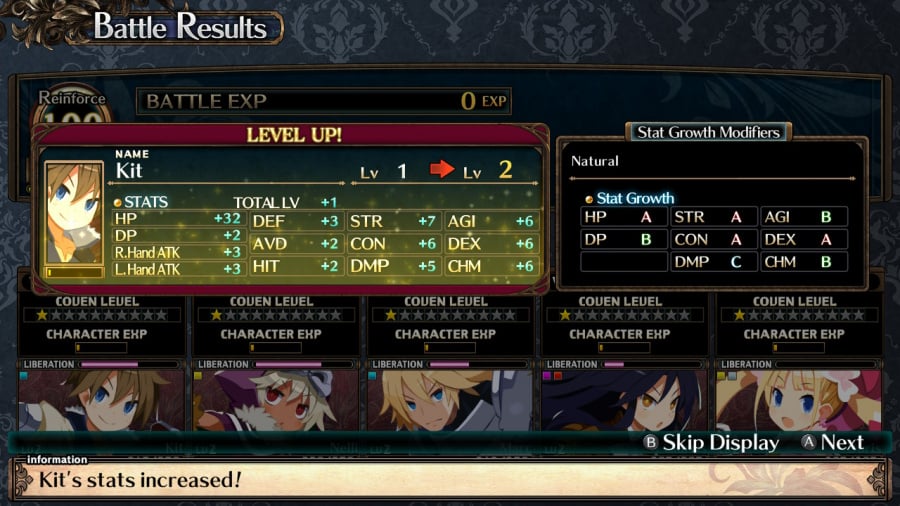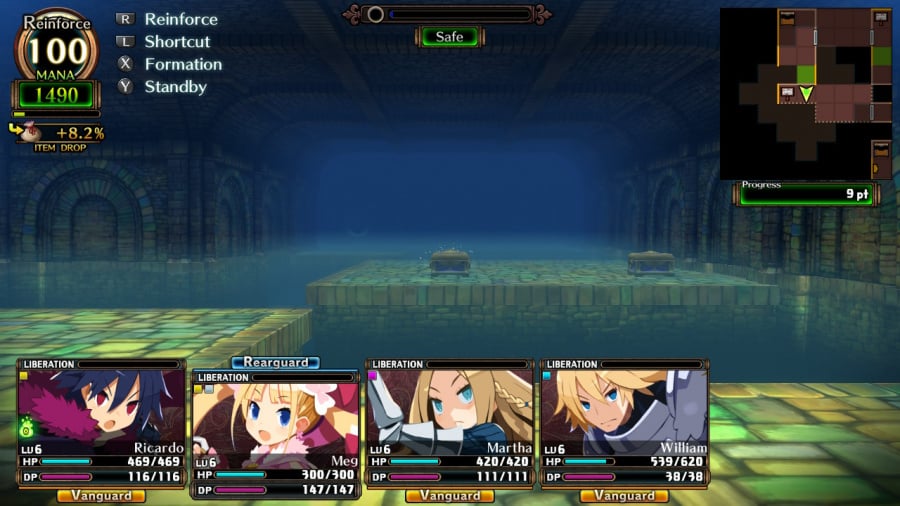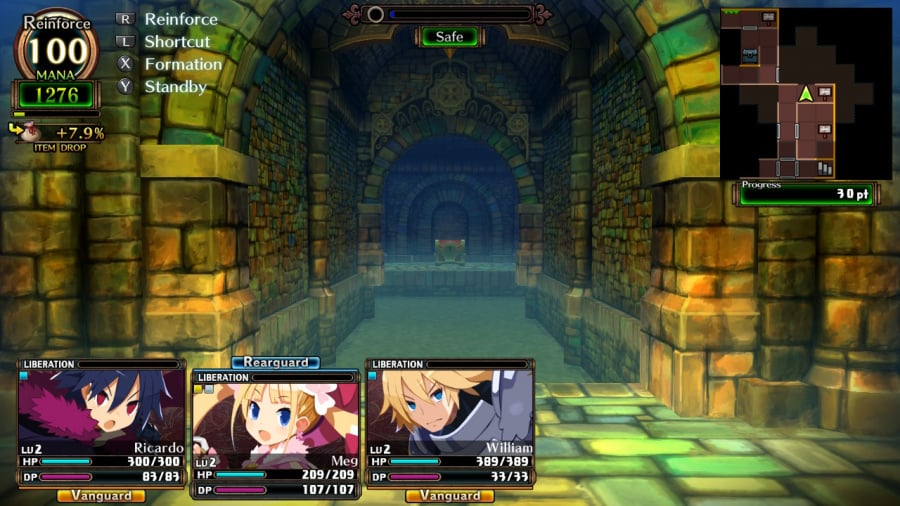Though the JRPG has remained the de facto king of the RPG space for the last few decades, one could argue that the popular genre would never have existed were it not for DRPGs. What started in eons past with titles like Ultima and aimed to translate a traditional D&D gameplay experience to the screen has given way to more approachable dungeon-crawlers like Etrian Odyssey and Demon Gaze. In 2018, Nippon Ichi tried its hand at the subgenre with the enjoyable Labyrinth Of Refrain: Coven Of Dusk and it’s now opted to follow up on that experiment with Labyrinth of Galleria: The Moon Society. Though it’s clearly designed for a relatively narrow audience, there’s a lot to love about Labyrinth of Galleria.
Labyrinth of Galleria places you in the role of Eureka, a bright-eyed young girl responding to a job posting that sees her visiting a sketchy abandoned manor in the woods. Here, she is welcomed by the witchy Madame Marta, who quickly bonds her with a cute green ghost that Eureka names ‘Fantie’ and prompts her to use her spooky new friend to explore the vast labyrinth below Galleria Manor in search of powerful magical artifacts that the manor’s mysterious owner desires. No human can enter the labyrinth and return unharmed, so Marta teaches her how to use Fantie’s powers to imbue various puppets with life and direct them to explore the dungeon on her behalf. Eureka thus sets out on a vicarious quest into the depths below, while slowly learning more about her eccentric employers.

Though it feels like narrative isn’t exactly the focus here, the various visual novel-esque cutscenes at key milestones nonetheless help to instill Labyrinth of Galleria with quite a bit of charm. The writing and voice acting for most scenes is hammy without being cringy, and there are some genuinely dark and sudden twists that help to elevate the story beyond simple window dressing for the dungeoneering action. We won’t be spoiling anything, but suffice it to say this plot goes places you wouldn’t expect, and we applaud the developers for their willingness to shake up conventions and keep the player guessing.
Gameplay in Labyrinth of Galleria follows the typical DRPG structure in which you explore grid-based dungeons from a first-person perspective. Every step will advance time by one unit, which usually just means enemies take another step, and you gradually fill out a dense, yet simple map that makes revisits more of a breeze. Along the way, you find treasures to build up your party, enemies to overcome, and stairs to take you to other floors full of all kinds of good and bad things. It’s a pretty simple setup, but one which remains consistently engaging, especially when you factor in special abilities. For example, you get a wall-breaker ability early on that lets you bust through most walls like the Kool-Aid Man, and this creates all kinds of new strategies for evading enemies or discovering new or more convenient routes through the dungeon.

Or, in another example, some sections require you to use an ability that lets you go underwater, where you have to manage your air. It always feels like there’s something dangerous around each corner, whether that be a powerful foe looking to ruin your day or a pitfall trap that’ll cripple most of your party, and this leads to a delightful tension as you push ever deeper.
Every few minutes, you’ll get into fights with enemies (though you can evade them, if needed) and combat here unfolds with a standard turn-based approach. The main gimmick is the Coven system, which enables you to eventually control a few dozen characters at once by letting you slot a small party into each one of your party slots. Covens act as a sort of formation for a group of characters and have them all act as if they’re one character, and these can be tweaked and experimented to accommodate an array of roles and action types. Sometimes you’ll want an all-DPS crew, while other times you may want to mix in a tank or two to add more options and shore up survivability. It’s a lot to get to grips with, but we felt this unconventional take on expanded team-building added a lot to the otherwise rote combat.

In fact, once you start to really get into the weeds of it, it’s easy to see the Disgaea influence on Labyrinth of Galleria’s incredibly in-depth character customization. Every character you create is drawn from the same expanding pool of base classes, but they can be differentiated by changing things like their ‘stance’ or ‘nature’ to alter parameters like specific stat or XP gains. From this, they can then be assigned to a Coven which can in turn be assigned a Pact that will determine the active skills they can use and level up independently from them, sort of like a Job from the Final Fantasy games.
Building an effective team is thus a matter of using trial and error to find the niche that you want each character to fulfill. And this goes beyond the typical broad decision of whether you want a character to be DPS or Tank, as there are loads of different kinds of DPS or Tank units that you could possibly make.
Luckily, most trash mobs don’t really test your team composition too hard, but each boss acts as a rough skill check that’ll happily send you back to the drawing board every time you fail. And while grinding can help to soften poor planning on your part, it’s not as reliable a method of forcing progress as it is in other RPGs. Labyrinth of Galleria feels most like Disgaea in the sense that its gameplay is as much (if not more) about what you’re doing in menus for team-building as it is actually playing the game. There are few things more rewarding than seeing a well-oiled team steamroll the opposition after countless painstaking attempts to compare stat tables on equipment and weighing the benefits of switching team members and Pacts between Covens, but the other side of this is that those who aren’t as allured by min-maxing in an RPG may feel a bit left out. Labyrinth of Galleria is a game for those who love to stare at spreadsheets and adjust numbers to see how it affects other numbers; if that isn’t you, then this title will probably struggle to hold your interest.

Even if you do gel with this more analytical approach to an RPG, one big complaint that we have with the gameplay loop is that some mechanics and progression-based milestones can be a bit too opaque. For example, one early quest required us to find and retrieve a specific treasure. It didn’t tell us which floor this treasure was on, nor did it have any hints or clues to even give us a general idea of where to begin to look. After spending an hour or two going way too deep into the dungeon for that point in the story, we eventually caved and resorted to an online guide, which showed us that the treasure was hidden in a secret room behind a completely unmarked and otherwise ordinary wall that we had to break through.
Though we genuinely appreciate that Labyrinth of Galleria is a wonderfully dense and complicated game, it’s not uncommon to run into instances like this where we wished it was a bit less obtuse. This is the kind of game that expects you to attempt to break every wall in the dungeon until you find the one that lets you progress further. One could argue, of course, that the first full run through the game is in fact the ‘tutorial’ for the next part, but if you’re not prepared and willing to approach it on those terms, you’ll likely feel that Labyrinth of Galleria is unwieldy and confusing at times.
In terms of presentation, Labyrinth of Galleria applies Takehito Harada’s signature anime art style to brilliant effect, with every character sprite looking sharply drawn and brightly colored. Plus, in the various cutscenes, the backdrops feature gorgeously detailed, painted locales that often have a perfect otherworldly spookiness to them. And though the 3D dungeons are a slight step down in visual excellence, they nonetheless do a great job of projecting an oppressive and endless kind of presence on the player that adds to their mystique and intrigue.

The soundtrack matches these visuals perfectly with a special brand of goofy, Halloween-esque track that helps to set an effective tone. It’s creepy without being scary; silly without being stupid. And though it feels like some of these tracks can get a little repetitive given how long you spend crawling around in some dungeons, we felt that the music overall nailed what it was going for.
Conclusion
Labyrinth of Galleria: The Moon Society does a fantastic job of providing a dense and devastating journey into the depths of dungeons, though it sometimes does so at the cost of accessibility. An attractive art style, expansive team-building options, and genuinely surprising story all combine to make this one worth a recommendation, but with the big caveat that a lot of its appeal is lost if you don’t enjoy min-maxing in RPGs or don’t have the patience to fully digest and comprehend all its systems. If that does sound like it’s up your street, though, Labyrinth of Galleria is absolutely worth your time and money.
Read the full story at: Source link
